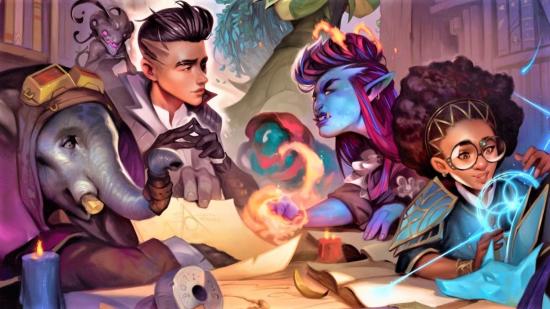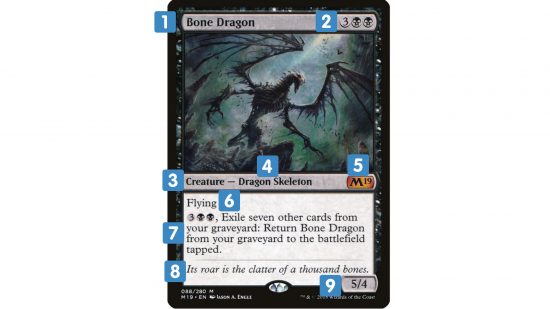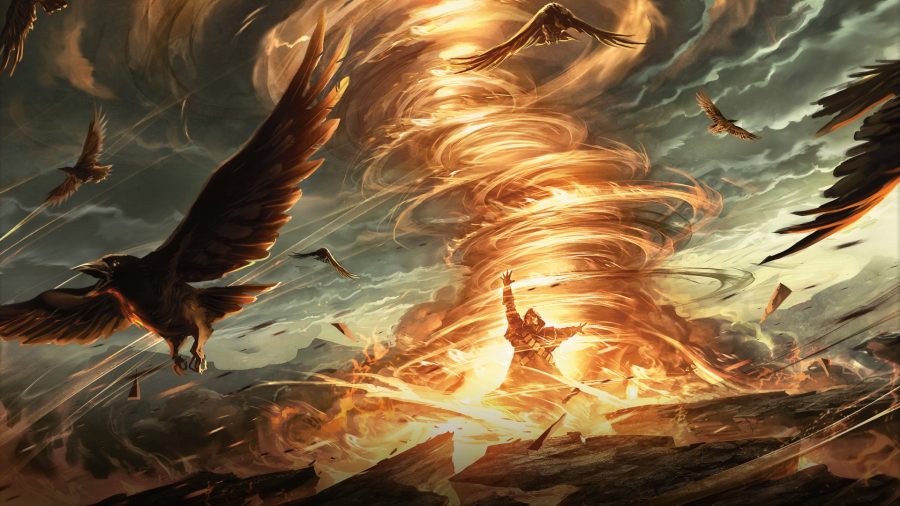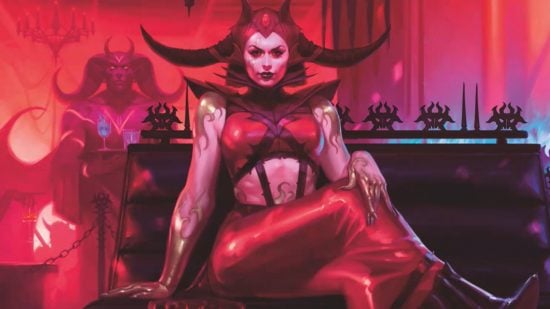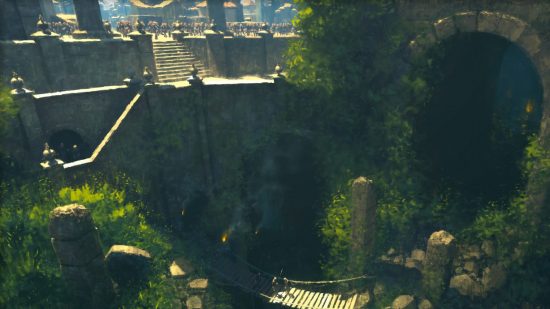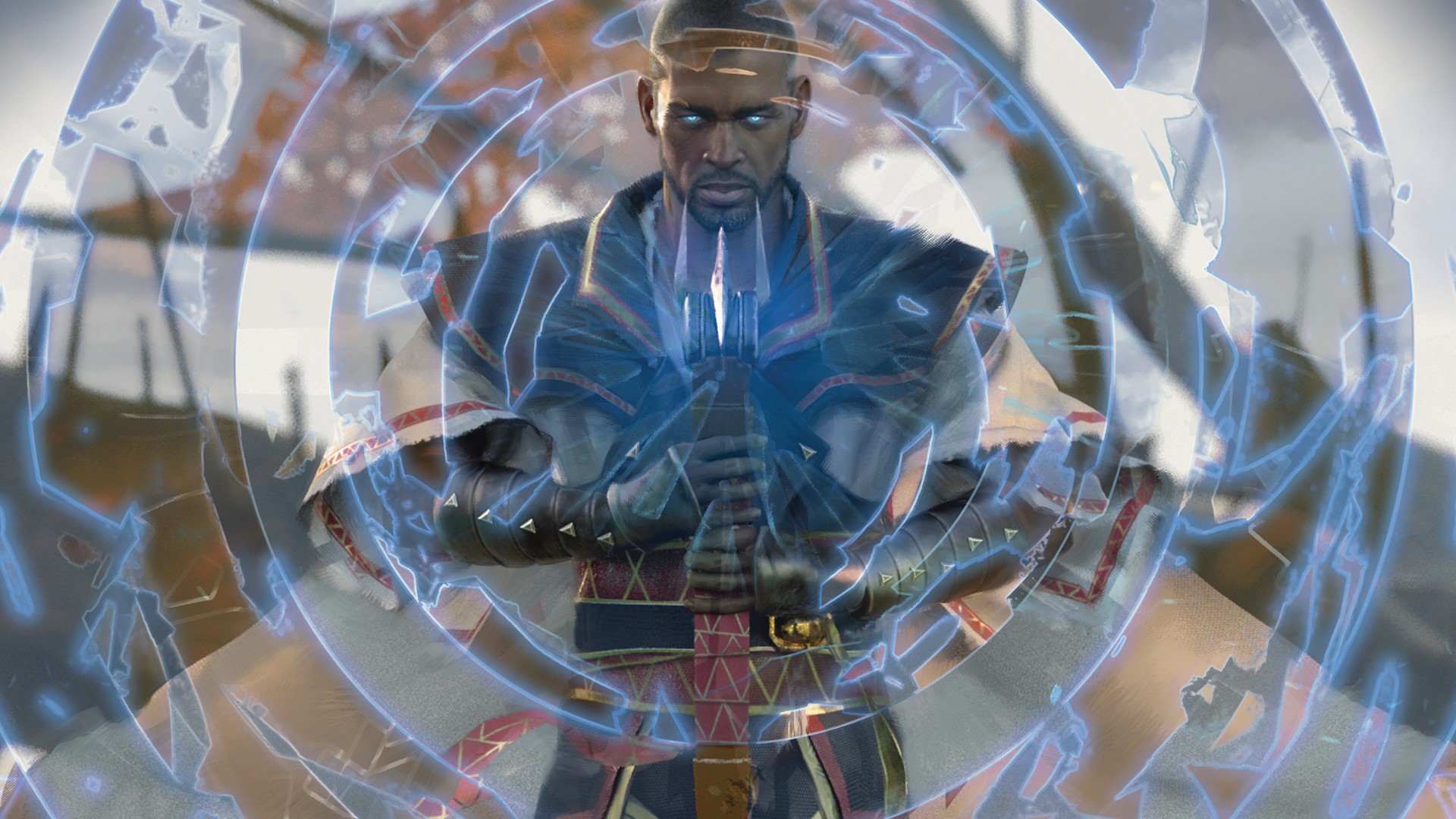In Magic: The Gathering, you take on the role of a powerful wizard, summoning creatures and casting spells from your personal deck as you try to knock your opponent down to zero life points. This guide explains how to play Magic: the Gathering in easy steps, and is perfect for beginners.
This guide explains the core Magic: the Gathering game systems in simple language. If you want an interactive tutor, the online game Magic: The Gathering Arena is free to play, and has great single-player tutorials. After you’ve finished your training there, check out our guide to MTG Arena Codes which will allow you to unlock free booster packs with extra cards to continue the fun.
Here’s how to play Magic: the Gathering:
- How to read an MTG card
- The MTG battlefield
- Understand the MTG card types
- How to start playing Magic: The Gathering
- How do turns work in Magic: The Gathering?
- How to play cards in Magic: the Gathering
- What is ‘tapping’ and ‘untapping’ in Magic: the Gathering?
- Attacking and blocking in Magic: The Gathering
- How do MTG abilities work?
- The stack
- How to play Magic: The Gathering online
- Experiment, explore, and enjoy
How to read an MTG card
MTG cards have a lot of information on them. Here’s what the different text, numbers, and symbols on this Bone Dragon mean:
- Name: The card’s name.
- Mana Cost: The resources you will need to spend to cast the Bone Dragon spell: in this case, two black mana (the skull symbol) and three mana of any color.
- Card type: Every Magic card has a “type”: a Land, Instant, Sorcery, Enchantment, Artifact, Creature, Planeswalker, or Battle. The card’s type affects how it works in the game. The Bone Dragon is a creature.
- Card subtype: The Bone Dragon has two subtypes: dragon and skeleton. These subtypes might be referenced by other cards.
- Set symbol: This part of the card tells you its MTG card rarity (shown by the color) and which MTG set it is from (shown by the symbol)
- Keywords: At the top of Bone Dragon’s text box, we find it has the MTG Keyword ‘flying’, which gives it a special rule. There are many keywords, but you’ll only need to learn a few to get started.
- Rules text: Rules text explains any special effects of the spell. For some cards, these will be a one-time effect. For this Bone Dragon, it has a special ability that you can pay mana to use while card is in your graveyard (discard pile).
- Flavor text: This is just for fun – it has no rules implications. It is fun though!
- Power and Toughness: Only Creatures have this section. Power is the left number, the amount of damage the creature deals in combat. Toughness is the amount of damage a creature can take in one turn before it is destroyed.
The MTG Battlefield
Games of Magic the Gathering take place across a ‘battlefield’.
Hand: Your hand contains the cards that you can play. You will draw seven at the start of the game, and one new card each turn. The maximum hand size is seven cards.
Deck: Your deck is made up of lands and spells. In most 1 v 1 formats, your deck will contain 60 cards. Lands give you the mana resources you need to cast spells. Spells are your tools to defeat your opponent – they can do almost anything.
Lands: When you play a land, you put it at the back of the battlefield. You will use lands to generate the mana you need to cast spells.
Creatures and other non-land permanents: When you cast a creature, artifact, enchantment, Planeswalker, or battle spell, it will go at the front of your side of the Battlefield. These are called ‘permanents’, because they remain on the Battlefield and continue to have an effect until they are destroyed or exiled.
Graveyard: When a permanent is destroyed, a card is discarded, or an instant or sorcery spell finishes resolving, it goes to the graveyard. There are other ways for cards to go to the graveyard. Some Magic decks can make use of the graveyard as another resource.
Exile zone: Some effects “exile” cards. This puts them outside the game – they’re not even in the graveyard.
Understand the MTG Card Types
Every Magic card has at least one type. A card’s type has a big effect on how it works in the game.
Card types are either permanents, or non-permanents. After you cast a permanent spell, or play a land, it sits on the battlefield until something happens to remove it. You may normally only play permanent cards during your first or second main phase.
Lands generate the mana resource you need to cast your spells. You may play one land per turn from your hand. Lands are permanents. They are not spells – you don’t need to pay mana to put them into play, and they cannot be ‘countered’ by counter-spells.
Sorceries have a one-time effect. When you cast a sorcery from your hand, it has an effect right away, such as dealing damage to a creature, or letting you draw some cards. Once that’s resolved, the sorcery goes to the graveyard. You can only cast a sorcery spell during one of your main phases.
Instants work just like sorceries, but unlike sorceries, you may cast them at (almost) any time. That includes during your opponent’s turn, or in response to game actions, like your opponent declaring a blocker, or the turn moving from one phase to another.
Creatures are permanents. Creatures can attack your opponent, causing damage that reduces their life points. They can block attacking creatures, absorbing incoming damage. They often have other abilities.
Enchantments are permanents, and can have all sorts of useful abilities.
Artifacts are permanents, and can have all sorts of useful abilities.
Planeswalkers are permanents. They enter the battlefield with a number of ‘Loyalty’ counters on them. Your opponent’s creatures can attack a Planeswalker instead of you, and the damage they deal reduces the Planeswalker’s Loyalty by the same amount. Once the Planeswalker’s loyalty hits zero, it goes to the graveyard.
Planeswalkers have ‘Loyalty’ abilities – you can use one each turn. These could have almost any effect, from damaging enemy creatures to drawing cards. Some of these abilities increase the Planeswalker’s Loyalty, while more powerful abilities decrease the Planeswalker’s Loyalty.
Battles are permanents. They enter the battlefield with a number of Defense counters on them, and they usually have an effect when they enter the Battlefield. One player has to ‘defend’ the battle – it goes on their side of the Battlefield, and their opponent can attack it, removing Defense counters from it. When the last counter is removed, something interesting happens!
If you want to understand the differences between card types in greater detail, check out this dedicated guide to the MTG card types.
How to start playing Magic: The Gathering
To start playing MTG, you’ll need an opponent, and two decks of sixty Magic cards. The starter kit below is a budget friendly option to get two decks.
Both players start with twenty life points. You defeat your opponent if you reduce their life points to zero, or if they need to draw a card but they their deck is empty.
Randomise who will take the first turn. Both players then shuffle their library, give their opponent the opportunity to cut their deck, and then draw a hand of seven cards.
If you don’t like your starting hand, you can ‘mulligan’, shuffling it back into your library, drawing another seven cards, and then placing one of them onto the bottom of your library. You can keep doing this, but you’ll have to put more and more cards back each time.
How do turns work in Magic: The Gathering?
Magic the Gathering turns go through a series of phases.
Beginning phase
The beginning phase has three steps –
- Untap: All your tapped permanents untap.
- Upkeep: The ‘upkeep’ step doesn’t do anything by itself, but some card abilities might reference it.
- Draw: You draw one card from the top of your deck. If it’s the first turn of the game, and you are the first player, skip this step.
Pre-combat main phase
In the pre-combat main phase you may play up to one land card from your hand to the battlefield, and you may cast any spells that you can afford to pay the mana costs of. You can do these in any order.
Combat phase
The combat phase has five steps:
- Beginning of combat: some cards might reference ‘the beginning of combat’ – any effects related to the beginning of combat happen now.
- Declare attackers: you announce which creatures you will attack with, and tap them.
- Declare blockers: your opponent declares which of their creatures are blocking which of your creatures.
- Combat damage: attackers and blockers deal damage to one another, and may be destroyed. Unblocked attackers deal damage to your opponent, reducing your opponent’s life points.
- End of combat: some cards might reference the ‘end of combat’ – any effects related to the end of combat happen now.
Post-combat main phase
The post-combat main phase is identical to the pre-combat main phase. If you already played a land in the pre-combat main phase, you can’t play one now.
Ending phase
The ending phase marks the end of the turn. It has two steps:
- End step: the last chance for players to take actions, such as casting an instant spell.
- Cleanup step: damage is removed from all creatures; if the active player has more than seven cards in their hand, they must discard down to seven; effects that last until the end of the turn now end.
Once all these phases have been completed, your turn is over – your opponent now gets this turn. This continues until one player loses the game, usually because their opponent has reduced their life points to zero.
We have a separate guide to all the MTG phases if you want to go into a specific phase in more depth.
How to play cards in Magic the Gathering
You can play one land card each turn, during either your pre-combat main phase or your post-combat main phase. The land enters the battlefield under your control, and stays on the battlefield until it is removed by some other effect.
To play a spell card, you must cast it. To cast a spell, you must first generate enough mana to pay for its casting cost, and then spend that mana to cast the spell. What happens next depends on the type of spell you are casting, but typically, it will usually have a one-time effect and then go to the graveyard, or it will become a permanent that stays on the battlefield until it is removed.
Mana and Mana costs
Mana is the resource used to pay for spells in Magic the Gathering. There are five colors of mana – white, blue, black, red, and green. Thematically, each color of mana corresponds to a different style of magic – our guide to the MTG colors explains them all.
Practically, the mana cost of different spells calls for different colors of mana. A mana cost is usually a number followed by one or more mana symbols. The number can be paid with any color of mana, while the symbols must be paid with mana of the corresponding color.
Generating mana
The most common way to generate mana is with lands. The ‘basic lands’ all have the ability to generate mana of one specific color:
| Land | Mana | Symbol |
| Plains | White | |
| Island | Blue | |
| Swamp | Black | |
| Mountain | Red | |
| Forest | Green |
Once a land is in play on your side of the battlefield, you may tap it at any time to generate one mana of the corresponding color. This goes into your ‘mana pool’. You can then spend that mana to cast a spell.
Mana drains away from your mana pool whenever a step or phase of the game ends, so you can’t store it up. Generating mana does not give your opponent a chance to react with an instant spell or ability, but as you will usually use that mana to do something else, they’ll have a chance to react then.
When can I cast spells in MTG?
You may play any card or cast any spell during either of your main phases. You may play instant cards at almost any time – immediately after you have taken any action, and immediately after your opponent takes most forms of action.
Casting permanent spells
When you pay the mana cost for a creature, artifact, enchantment, Planeswalker, or battle, you cast the spell. Your opponent then has a chance to react with an instant or an ability. Assuming this doesn’t stop your spell being successfully cast, the spell ‘resolves’ into a permanent, which sits on your side of the battlefield.
Creatures have summoning sickness when they enter the battlefield. You cannot take any action with them that would tap them. The main effect of this is that they cannot attack on the turn they enter the battlefield. Other permanents do not have summoning sickness.
Most of the usefulness of permanents comes from their abilities. Often, these are written in a way that is easy to interpret, but there’s a section lower down in this guide that explains the kinds of abilities in more detail.
Casting non-permanent spells
When you pay the mana cost for an instant or sorcery, you cast the spell. Your opponent then has a chance to react with an instant or an ability. Assuming this doesn’t stop your spell being successfully cast, the spell ‘resolves’. It has an effect, and then the card goes to the graveyard.
What is ‘tapping’ and ‘untapping’ in Magic the Gathering?
Magic the Gathering permanents are either ‘tapped‘ or ‘untapped‘. Think of an ‘untapped’ permanent as one that is fresh and ready for action, and a ‘tapped’ permanent as one that is exhausted. Normally, permanents enter the battlefield untapped, and become ‘tapped’ when you take certain actions.
Whenever you need to tap a permanent to use an ability, that will be indicated on the card with the tap symbol:

To tap a permanent, turn the card sideways – it is now tapped. Normally it will remain tapped until the your next untap step, when it will untap. To show that a permanent is untapped, turn it upright.
Many actions and abilities will require you to tap a permanent to gain the benefit. These are common actions that require you to tap a permanent:
- Tap a land to generate mana.
- Tap a creature to attack with it.
- Tap a permanent as the cost of using an activated ability.
Once a permanent is tapped, it cannot be tapped again until it has first untapped. Tapped creatures cannot block attacking creatures – they’re too sleepy.
Attacking and blocking in Magic the Gathering
During your combat phase, you will attack your opponent with your creatures, and they will have the chance to block with theirs. Attackers and blockers will deal damage to one another, and unblocked creatures will deal damage to your opponent.
This is a very important part of the game. Although there are many ways to win a game of MTG, the most common is to reduce your opponent’s life total to zero by dealing combat damage with your creatures.
- In the declare attackers step, you will pick which of your creatures will attack your opponent, and tap them.
- In the declare blockers step, your opponent will pick which, if any, of their creatures will attempt to block your attackers. Only untapped creatures may block.
- The defender matches up their blockers with the the attackers they want to block. Multiple blockers can gang up on a single attacker, but defenders can’t block more than one attacker each.
- If an attacker is facing multiple blockers, the attacker gets to decide which order it will deal damage to the blockers in.
- In the combat damage step, unblocked attackers deal combat damage to equal to their power to the opponent. This reduces your opponent’s life points by the same amount.
- Attackers and blockers deal damage equal to their power to one another simultaneously.
- If an attacker faces multiple blockers, it will deal combat damage equal to its power to the first blocker. Excess damage spills over onto the second blocker, and so on, until all the damage is used up, or all the blockers have taken damage equal to at least their toughness. All the blockers deal their combat damage to the attacker.
- When a creature has received damage equal to its toughness, it is destroyed – this is common in combat! Whenever a creature receives damage, it sticks around on the creature until the end of the turn, so it’s possible to slowly kill a creature by dealing damage several times during a turn.
Many creatures have MTG keywords in their rules text boxes that affect them in combat. These are the most common ones:
- Flying: Creatures with flying can only be blocked by other creatures with flying.
- First strike: Creatures with first strike deal their combat damage before creatures without first strike, so may be able to kill an attacker or blocker before it deals damage.
- Trample: When an attacking creature with trample has dealt combat damage to all of its blockers and still has excess damage, that damage is dealt to the opponent.
- Deathtouch: Any amount of damage caused by a creature with deathtouch will kill the creature it damages.
- Lifelink: When a creature with lifelink deals damage, its controller gains that much life.
How do MTG abilities work?
Almost all MTG cards have abilities that provide them with additional effects. There are three main types:
Static abilities are always in effect. The keyword flying, which means a creature can only be blocked by other creatures with flying, is a static ability, because it never turns off.
Triggered abilities occur automatically whenever a specified event happens in the game. For example, a card might say “whenever one or more other creatures dies, target opponent loses one life”. Each time the trigger occurs, the effect happens.
You can choose when to use activated abilities. Each activated ability has a cost that you must pay, and an effect that you get. This is indicated in this format:
[Cost] : [Effect]
It’s common for permanents to have activated abilities. For example, all basic lands have the activated ability:
Tap : Add one mana of a specific color to your mana pool.
The cost to use the ability is tapping the land, and the effect is gaining mana.
Unless they say otherwise, activated abilities can be used at any time that you could cast an instant spell. The wording of abilities also puts specific limits on when they can be used: if an activated ability has as a cost that says “discard this card”, it can only be used when the card is in your hand, not when you have played the card and it is on the battlefield, or in the graveyard.
The stack
Whenever a player takes most kinds of action, first they and then their opponent have a chance to respond to it by casting an instant spell or using an activated ability. The action may also activate the triggered abilities of cards that are already in play.
In fact, you can keep going like this, chaining abilities and triggers one after the other. This process is kept neat and tidy by ‘the stack‘.
- Whenever a player casts a spell, an ability is triggered, or an ability is activated, it is placed onto the ‘stack’. This is an imaginary zone where game events exist before they have been resolved and take effect.
- If the player or their opponent responds by casting an instant spell or using an activated ability, or if any other triggered abilities have been activated, they will go onto the stack as well, on top of the previous item.
- Once there are no more triggered abilities, and neither player wants to react, the stack is resolved. This works on a “first in, last out” basis. The last trigger, spell, or ability to go on the stack resolves first, then the next one, and so on.
Spells and abilities that are cast later might have an affect on ones that are cast earlier. Counterspell is a great example – it counters a spell that’s already on the stack. When counterspell resolves, the spell it targets is countered, and goes to the graveyard without resolving.
Sometimes, you might be able to cast a spell, but by the time it resolves, it’s no longer useful, or its original target no longer exists. For example, suppose you cast Giant Growth, giving one of your creatures +3 power and +3 toughness. In response, your opponent casts Lightning Strike, dealing three damage to the same creature. Lightning strike resolves first.
If it kills the creature, that creature will be dead before Giant Growth can take effect. Not only that, but the target of the Giant Growth no longer exists – the spell “fizzles”, and goes to the graveyard without resolving.
As you resolve the stack, you might add new things to it! For example, a triggered ability might inflict one damage to your opponent whenever a creature is destroyed. When an effect resolves that destroys a creature, that ability will be triggered, and added to the top of the stack.
Likewise, as each ability on the stack resolves, you and your opponent have an opportunity to react with new activated abilities, or instant spells.
How to play Magic: The Gathering online
If you’d be more at home clicking cards on a screen than sliding them across a table (and want to get started with the world’s best card game for free), we’d recommend trying out MTG Arena.
It’s a less social experience than paper Magic, but a super accessible entry point. You’ll get your own guided tutorial and the opportunity to practice playing against a computer. Plus, you’ve got easy access to a dictionary of Magic keywords – simply hover your mouse over any card to read its text and learn what its abilities mean.
We have a guide to the current best MTG Arena decks if you want to know kind of decks are performing well in the most popular formats.
Experiment, explore, and enjoy
Once you’ve learned the basics of how to play Magic: The Gathering, the multiverse is your oyster. There are so many different paths you can take next; it just depends where your interests lie.
You may want to try other MTG formats, for example. There are many of these, but we recommend that new players try Commander or Jumpstart first.
MTG Commander
A popular format often played in groups of four, Commander is one of the most sociable ways to play Magic.
You can learn how to build an MTG Commander deck by yourself, but you can also buy a pre-constructed deck if you don’t feel ready for that much freedom. Wizards releases new pre-cons on a regular basis, so simply find a theme or MTG color combination that piques your interest, and get playing.
Commander will require a bit more of a monetary investment than you’ve put in so far, but on the plus side you’ll get to try out a version of Magic with more variety and ridiculous, bombastic moments than any other. Here are some of the best MTG commanders to try.
MTG Jumpstart
If you find you’re worried about getting crushed by more experienced players, we recommend the level playing field of the Jumpstart format. In Jumpstart, players open up two packs and bosh them together into a random deck. It’s not only a super quick and fun way to play Magic: The Gathering, Jumpstart will also give you a sense of the variety MTG has to offer and even give you a feel for deck-building, as you see how unexpected cards can work together.
We predict that before long you’ll have a towering stack of MTG cards in your collection. At that point, it’s handy to know how to build an MTG deck. And if you’ve got hold of some strong cards and want to up your game, here are some of the best MTG Standard decks to try out.
Either way, we hope we’ve filled you in to put you in a strong position for your first game of MTG – be it online or off.
